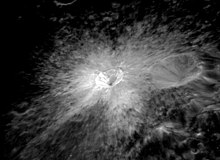Censorinus (crater)
 Oblique view from Apollo 16 showing bright rays | |
| Coordinates | 0°24′S 32°42′E / 0.4°S 32.7°ECoordinates: 0°24′S 32°42′E / 0.4°S 32.7°E |
|---|---|
| Diameter | 3.8 km |
| Depth | 0.4 km |
| Colongitude | 328° at sunrise |
| Eponym | Censorinus |



Censorinus is a tiny lunar impact crater located on a rise to the southeast of the Mare Tranquillitatis. It is named after the ancient Roman writer Censorinus.[1] To the northeast is the crater Maskelyne.
Censorinus is distinguished by an area of high-albedo material surrounding the rim. This makes the feature highly prominent when the Sun is at a high angle, and it is one of the brightest objects on the visible Moon. Bright streaks radiate away radially from the crater, and contrast with the darker lunar mare.
This formation has a sharp-edged, raised rim and a symmetrical, cup-shaped interior. Close-up photographs of this crater by Lunar Orbiter 5 show many large blocks lying along the sloping outer rampart. The surface near the crater is hummocky from the deposited ejecta. The crater is otherwise undistinguished.
The vicinity of Censorinus was once considered for an early Apollo landing site.[2]
Satellite craters[]
By convention these features are identified on lunar maps by placing the letter on the side of the crater midpoint that is closest to Censorinus.
| Censorinus | Latitude | Longitude | Diameter |
|---|---|---|---|
| A | 0.4° S | 33.0° E | 7 km |
| B | 2.0° S | 31.4° E | 8 km |
| C | 3.0° S | 34.1° E | 28 km |
| D | 1.9° S | 35.8° E | 10 km |
| E | 3.6° S | 34.8° E | 12 km |
| H | 1.8° S | 33.7° E | 10 km |
| J | 1.0° S | 31.3° E | 5 km |
| K | 1.0° S | 28.8° E | 4 km |
| L | 2.5° S | 31.2° E | 4 km |
| N | 1.9° S | 36.5° E | 36 km |
| S | 3.8° S | 36.1° E | 17 km |
| T | 3.2° S | 31.1° E | 5 km |
| U | 1.5° S | 34.4° E | 3 km |
| V | 0.6° S | 35.4° E | 4 km |
| W | 1.0° S | 37.5° E | 9 km |
| X | 0.5° S | 37.2° E | 18 km |
| Z | 3.7° S | 36.8° E | 12 km |
The following craters have been renamed by the IAU.
- Censorinus F — See Leakey (crater).

Censorinus E
References[]
- ^ "Censorinus (crater)". Gazetteer of Planetary Nomenclature. USGS Astrogeology Research Program.
- ^ To a Rocky Moon: A Geologist's History of Lunar Exploration. Don E. Wilhelms, University of Arizona Press (1993). ISBN 978-0816510658
- Andersson, L. E.; Whitaker, E. A. (1982). NASA Catalogue of Lunar Nomenclature. NASA RP-1097.
- Bussey, B.; Spudis, P. (2004). The Clementine Atlas of the Moon. New York: Cambridge University Press. ISBN 978-0-521-81528-4.
- Cocks, Elijah E.; Cocks, Josiah C. (1995). Who's Who on the Moon: A Biographical Dictionary of Lunar Nomenclature. Tudor Publishers. ISBN 978-0-936389-27-1.
- McDowell, Jonathan (July 15, 2007). "Lunar Nomenclature". Jonathan's Space Report. Retrieved 2007-10-24.
- Menzel, D. H.; Minnaert, M.; Levin, B.; Dollfus, A.; Bell, B. (1971). "Report on Lunar Nomenclature by the Working Group of Commission 17 of the IAU". Space Science Reviews. 12 (2): 136–186. Bibcode:1971SSRv...12..136M. doi:10.1007/BF00171763. S2CID 122125855.
- Moore, Patrick (2001). On the Moon. Sterling Publishing Co. ISBN 978-0-304-35469-6.
- Price, Fred W. (1988). The Moon Observer's Handbook. Cambridge University Press. ISBN 978-0-521-33500-3.
- Rükl, Antonín (1990). Atlas of the Moon. Kalmbach Books. ISBN 978-0-913135-17-4.
- Webb, Rev. T. W. (1962). Celestial Objects for Common Telescopes (6th revised ed.). Dover. ISBN 978-0-486-20917-3.
- Whitaker, Ewen A. (1999). Mapping and Naming the Moon. Cambridge University Press. ISBN 978-0-521-62248-6.
- Wlasuk, Peter T. (2000). Observing the Moon. Springer. ISBN 978-1-85233-193-1.
External links[]
- Lunar Photo of the Day, "Land of Manna", October 5, 2006, showing Censorinus, and Censorius C, noted as similar to Gaudibert crater
- LQ20 quadrangle
- Impact craters on the Moon


